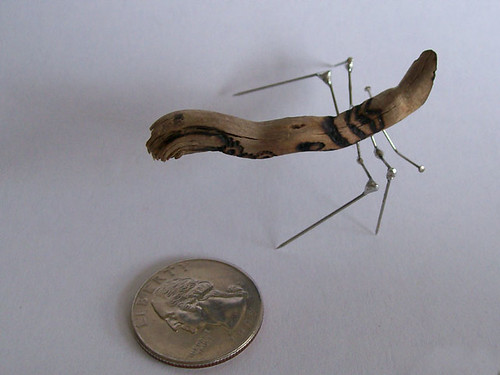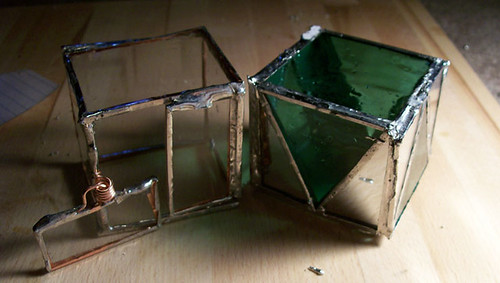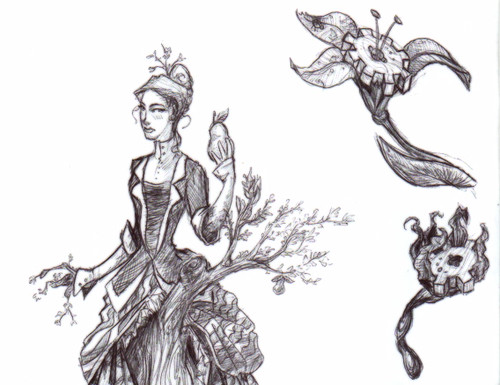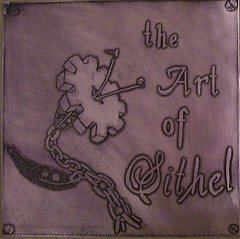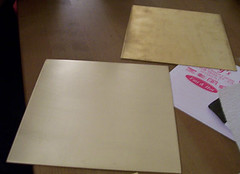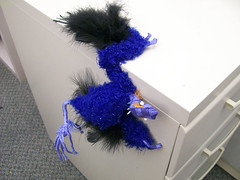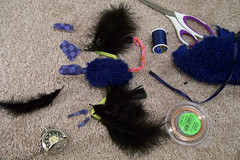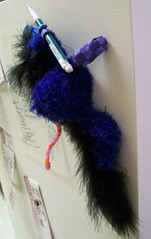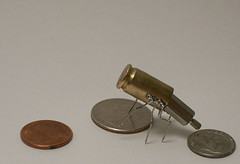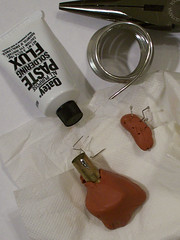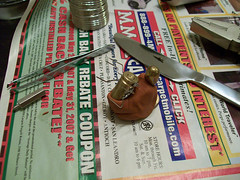Project : Damaged Messenger
Date : July 12th, 2007
Materials : Type writer parts [most notably the N/n striking bit, levers, and springs], copper tape, copper wire, pins, nails, a screw, drift wood, flux, far too much solder
Tools : Pair of pliers, soldering iron, saw, hammer
Finished Product:

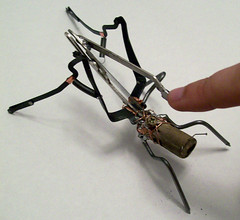


Process:
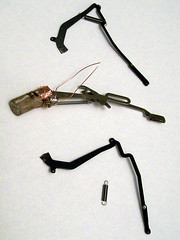
Yank out all the parts from the machine. I found gripping at the base with the needle-nose pliers and then just agitating it with constant little wiggles eventually broke the metal. Attach the striker to the.... 'tail spring' part. Cut a notch in drift wood and then cut to 'body' length. Line notch and base of wood with copper tape and spend far too long trying to both wedge the tail into place and solder it to the tape. Oh, and be sure not to let the tape fall off the wood. Score the wood with a soldering iron and wrap the base with wire- preferably catching it in the groves you just burnt. If you make a mess like I do, consider hiding it behind a screw which can also work in as a sort of anchor for the wires.
Now consider the hind legs. Wrap a thin strip of copper tape where you want one half of the spring to connect, then solder it down. Try, somehow, to bend them into a fitting position. Wrap the leg's connection point in copper tape and liberally apply solder to the entire thing. Struggle for at least 30 minutes to attach the legs straight to the tail, give up and wrap the wire around them for support. Now you'll find it's super easy to solder them down. Oh, if you really want to do it the Sithel way, be sure to damage your soldering tip somewhere at this stage. Now bend some nails and solder them to the copper tape, this can also help prevent wire wiggling and further anchor down the tail.
If you're not lazy, you might consider permanently attaching the other half of the springs, but I didn't bother. Add flare for personality such as pins for antennae and a stupid burnt gash for a mouth.
Thoughts :
So I found an old, semi-electric typewriter at an recycle store and nabbed it for a reasonable price. The keys are far from pretty, but I found myself drawn to the myriad number of springs and levers in the back, as well as the strikers which are so unique to the machine.
I list this as being quick- about 3 hours total- but I had spent nearly an entire evening previous pulling the machine apart and getting familiar with the pieces. It helped that I sad down the evening of construction with a relatively clear image in my head of what I wanted and how I'd get it from the start.
My original intent was a sort of scorpion feel, it turned out more grasshopper-esque, and photographs like a spider! The pivot for the "tail" is a unique and very fine piece I pulled from... somewhere. It was a fight to overcome the "I must save this till the *perfect* project comes up" feeling in order to actually *make* something. The key is of corse unique, but I'm not overly fond of the letter. The legs came jointed- they connect to the strikers so I've got quite a few left. The springs from below the keys- no shortage of supply there- and are of a very pleasing tension. At the same store I grabbed the typewriter, I scooped a bag of random bits for $0.50. During construction, I was quite sad to find that my first choice of black screws for the legs from wouldn't take solder and then that I only had 3 nails. My firm intent to finish the piece before the night was over drove me to using the nails and suffering the absence of a leg. Given how, upon finishing it, the story for the piece *leapt* out at me, I'm happy with my choice.
The screw was just added to cover my mess and the pins a last minute attempt to add pins to the project since I love them so. After I used the spring for the tail, I was determined to incorporate more spring joints into the piece. Playing with the tail is fun and pushing that extra bit to "squish" it- where its leg gives out and it drops to its tummy- is a quaint feature.
Like all things made by her, the creatures served a practical purpose that was obscured by a layer of secrecy and infused with a feeling of spite. The little assembly of messengers might appear impractical at first glance- larger then any folded slip of paper and prone to being noticed due to scuttling sounds as they traveled. A flock passing down a dark corridor would make the hair of any listener stand on end, so eerie was their faint metallic clicking of furiously moving limbs. But unlike a slip of paper or a errand boy prone to cracking under torture, the little constructs would never give up their message to any but the designed recipient. And while a slip of paper can be burnt before opening or a mortal messenger evaded, these devices would not rest till their intended knew exactly what the Master Architect wanted them to, no matter how unwelcome the words may be.
The contents which were spelt out via miniscule metallic twitches and the striking typebars were of course encrypted along with fall-backs in the event that not all arrived. The reactions of the message recipients varied. Some found the creatures to be delightfully quaint and amusing. Others shuddered with revulsion as they pressed the constructs' quivering typebar tales to encode their response. Miss Wells abhorred the little constructs- no doubt viewing them as perversions distantly related to her beloved press- and took every opportunity to vent her irritations and frustrations of them and their creator upon their delicate forms. If the messenger was not required for her response she would catch and destroy it, a task becoming increasingly difficult as they seemed to have learned to fear her. Any returning to Master Fletcher were sure to be damaged up to, but just shy of, being incapable of functioning: legs torn off, antenna battered, springs bent. One wondered why the Architect spent the effort on such a clearly doomed creation and if perhaps she would stop should Comrade Wells be less obvious in displaying the irritation they caused her.

